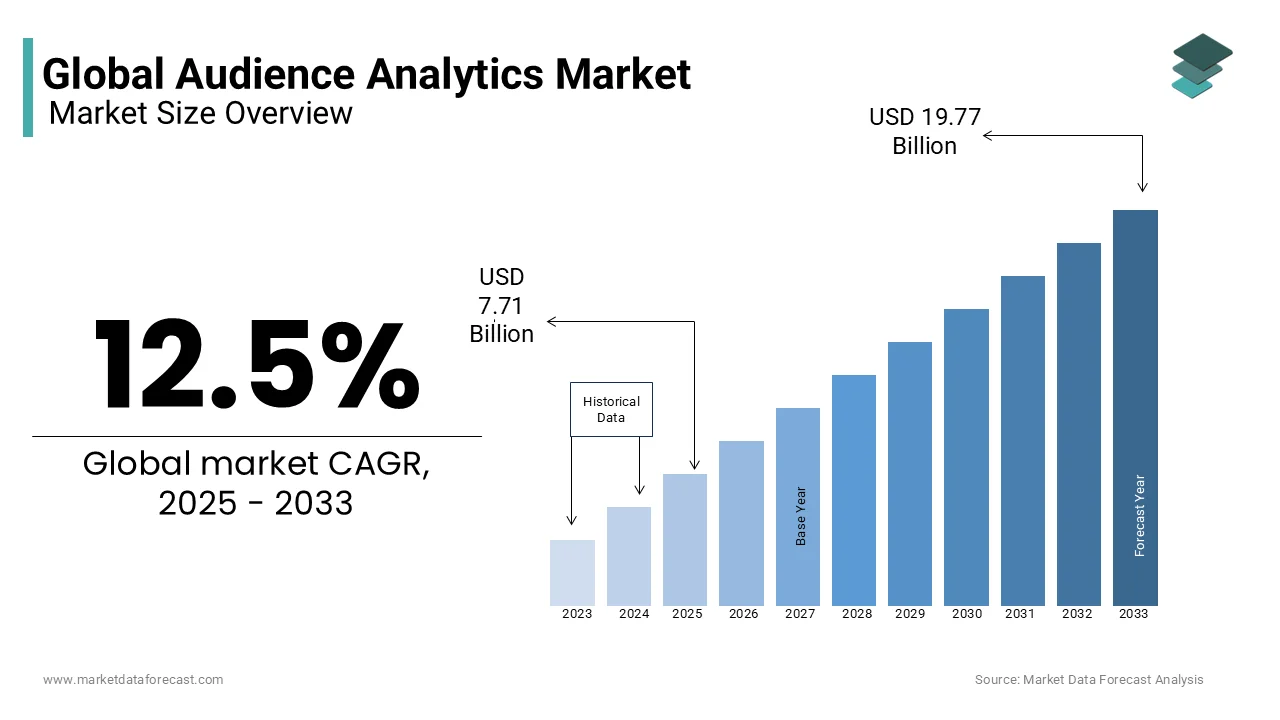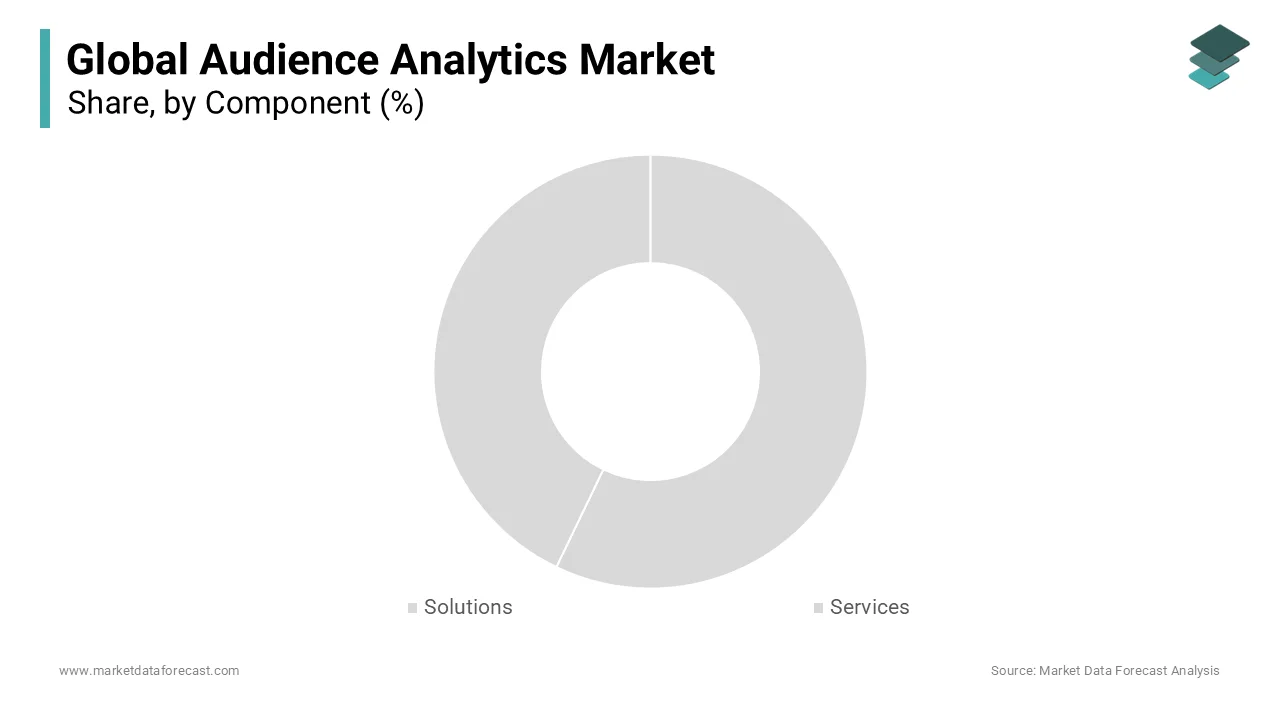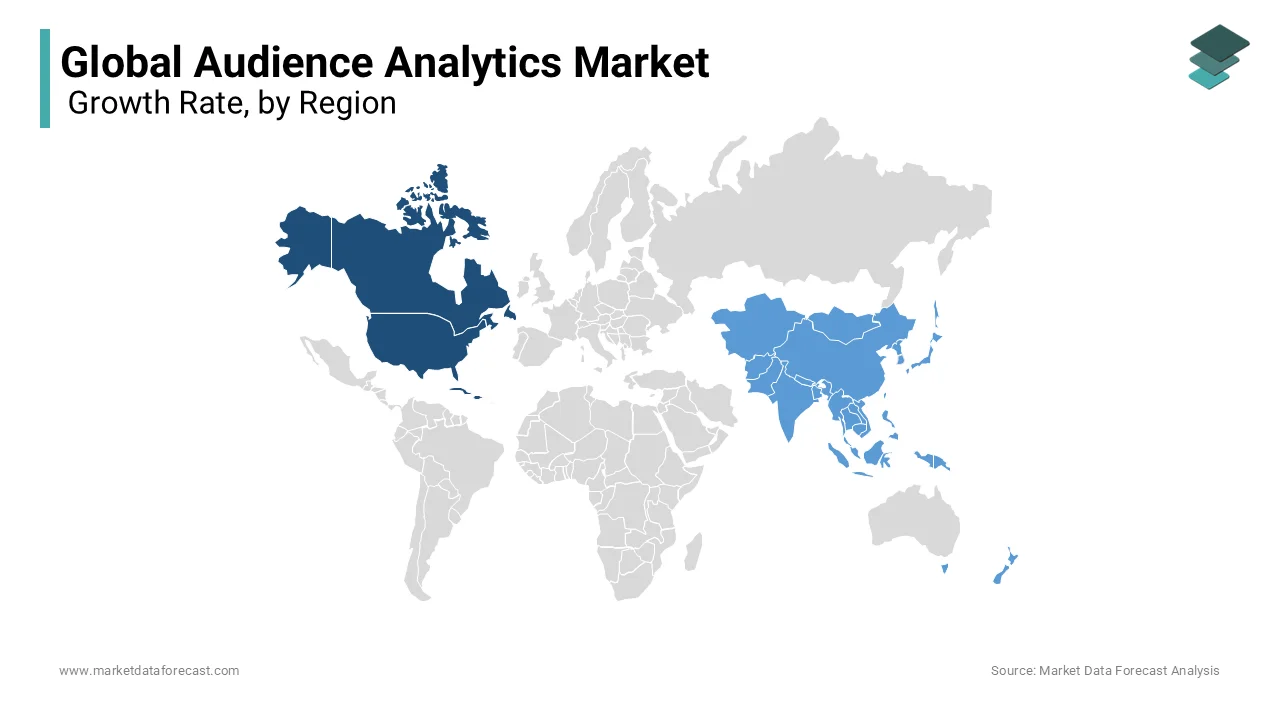Global Audience Analytics Market Size, Share, Trends, & Growth Forecast Report By Component (Solutions and Services), Application (Sales and Marketing Management, Customer Experience Management, and Competitive Intelligence), Organization Size (SMEs and Large), Vertical (Travel & Hospitality, Media & Entertainment, Retail & Consumer Goods, Telecommunications & IT, Health & Life Sciences, Government & Public Sector, BFSI & Others) & Region, Industry Forecast From 2024 to 2033
Global Audience Analytics Market Size
The size of the global audience analytics market was worth USD 6.85 billion in 2024. The global market is predicted to grow from USD 7.71 billion in 2025 to USD 19.77 billion by 2033, growing at a CAGR of 12.5% during the forecast period 2025 to 2033.

Audience Analytics is a robust data management platform that assists businesses in obtaining productive insights related to information on distinct audience profiles. It is a comprehensive platform that comprises predictive analytics, data management systems, and various multi-touch attributes. Technology is growing in popularity because it provides information between channels. Through audience analysis solutions, the business can obtain valuable information on aspects such as demographic information, psychographic information, CRM data, etc. This information provides functionality to create customer profiles and discover new customers or potential audiences, create profiles, and increase the number of current visitors. It helps discover the non-intuitive attributes of converters for audience expansion.
MARKET DRIVERS
The increase in e-commerce activities around the world is increasing the number of user engagements on digital platforms.
The growing interest of businesses in obtaining information through public engagement has led to increased adoption of audience analytics in several industries. Audience analytics technology is used for audience or viewer analysis. Audience Analytics offers actionable insights by recognizing the interests of consumers, along with the level of understanding, trends, and various other factors. It consists primarily of data management systems, predictive analytics technologies, and multi-touch attributes. It leverages cookie-based data, statistical data, and various other sources to develop an accurate audience profile, helping to optimize campaigns, systematically measure impressions, and take advantage of CRM models. and web data. It is widely used to reinforce trends in social channels and obtain information between channels. Audience analytics offer functionality to businesses to identify new users, track current visits, and non-intuitive attributes of converters for enterprise expansion.
Services are an important part of audience analysis offerings. Audience analytics services support the various phases of planning, implementing, maintaining, and updating audience analytics solutions. The various significant benefits of audience analytics services include huge cost savings, trained resources, 24/7 customer service availability, and support for companies using the analytics solution. SMEs have realized that immediate response, fast business decisions and customer satisfaction are the main characteristics necessary to grow their business, generate more income and guarantee the desired results. They face intense competition from large companies. Therefore, to gain a competitive advantage, SMEs adopt audience analysis solutions and services that would provide faster response, quick decisions, and customer satisfaction.
MARKET RESTRAINTS
However, security and privacy concerns related to public viewing data and the complexity of analytical workflows are important factors that are expected to lead to bottlenecks in market growth during the forecast period.
REPORT COVERAGE
|
REPORT METRIC |
DETAILS |
|
Market Size Available |
2024 to 2033 |
|
Base Year |
2024 |
|
Forecast Period |
2025 to 2033 |
|
CAGR |
12.5% |
|
Segments Covered |
By Component, Organization Size, Application, Vertical, and Region |
|
Various Analyses Covered |
Global, Regional & Country Level Analysis, Segment-Level Analysis, DROC, PESTLE Analysis, Porter’s Five Forces Analysis, Competitive Landscape, Analyst Overview on Investment Opportunities |
|
Regions Covered |
North America, Europe, APAC, Latin America, Middle East & Africa |
|
Market Leaders Profiled |
comScore (USA), Adobe (USA), Oracle (USA), IBM (USA), Google (USA), Unifi Software (USA), SAS (USA), Akamai (USA), Cxense (Norway), NetBase Solutions (USA), Cadreon (USA), Socialbakers (Czech Republic), Crimson Hexagon (USA), Quividi (France) , 3DiVi (USA), Flytxt (Netherlands), Telmar (USA), StoryFit (USA), Brandchats (Spain), Verto Analytics (United States), AnalyticOwl (United States), Verimatrix (United States), Brandwatch (United Kingdom), Sightcorp (Netherlands) and Lotame Solutions (United States). Other stakeholders in the global audience analytics market include cloud service providers (CSPs), government agencies, independent software vendors (ISVs), consulting firms, systems integrators, and service providers. managed (MSP)and Others. |
SEGMENTAL ANALYSIS
By Component Insights

REGIONAL ANALYSIS
Of these, North America, with the presence of leading players and early adoption of technology, accounted for a dominant portion of the worldwide marketplace. The Asia Pacific region is estimated to record the highest CAGR in the coming years. European nations like Germany, Switzerland, and others are further anticipated to create immense growth potential for this market in the foreseen period.

KEY PLAYERS IN THE MARKET
The audience analysis ecosystem includes service providers, such as comScore (USA), Adobe (USA), Oracle (USA), IBM (USA), Google (USA), Unifi Software (USA), SAS (USA), Akamai (USA), Cxense (Norway), NetBase Solutions (USA), Cadreon (USA), Socialbakers (Czech Republic), Crimson Hexagon (USA), Quividi (France) , 3DiVi (USA), Flytxt (Netherlands), Telmar (USA), StoryFit (USA), Brandchats (Spain), Verto Analytics (United States), AnalyticOwl (United States), Verimatrix (United States), Brandwatch (United Kingdom), Sightcorp (Netherlands) and Lotame Solutions (United States). Other stakeholders in the global audience analytics market include cloud service providers (CSPs), government agencies, independent software vendors (ISVs), consulting firms, systems integrators, and service providers. managed (MSP).
MARKET SEGMENTATION
This research report on the global audience analytics market has been segmented and sub-segmented based on the components, company size, application, industry vertical, and region.
By Component
- Solutions
- Services
By Organization Size
- Large Enterprises
- Small and Medium Enterprises
By Application
- Sales and Marketing Management
- Customer Experience Management
- Competitive Intelligence
By Vertical
- Travel & Hospitality
- Media & Entertainment
- Retail & Consumer Goods
- Telecommunications & IT
- Health & Life Sciences
- Government & Public Sector
- BFSI
- Others
By Region
- North America
- Europe
- Asia Pacific
- Latin America
- Middle East and Africa
Frequently Asked Questions
What are the key drivers of growth in the global Audience Analytics Market?
Key drivers include the rising demand for personalized customer experiences, the proliferation of digital content, the growth of social media platforms, and the increasing need for businesses to understand audience behaviors to optimize marketing strategies. Advancements in AI, machine learning, and big data analytics are also fueling market growth.
What industries are the largest users of Audience Analytics?
The media and entertainment industry is the largest user, leveraging audience insights to optimize content delivery and engagement. Other significant sectors include retail, telecommunications, healthcare, and financial services, which use audience analytics for targeted marketing, customer retention, and product development.
How do advancements in AI and machine learning impact the Audience Analytics Market?
AI and machine learning technologies enhance audience analytics by automating data collection, improving accuracy in predicting audience behavior, and providing deeper insights through advanced data processing capabilities. These technologies enable real-time analytics and personalized recommendations, leading to more effective marketing strategies.
What are the key technological trends shaping the future of Audience Analytics?
Key trends include the integration of artificial intelligence (AI) and machine learning (ML) for predictive analytics, the use of natural language processing (NLP) for sentiment analysis, the growing importance of cloud-based analytics solutions, and the shift toward real-time analytics for more immediate decision-making.
Related Reports
Access the study in MULTIPLE FORMATS
Purchase options starting from
$ 2500
Didn’t find what you’re looking for?
TALK TO OUR ANALYST TEAM
Need something within your budget?
NO WORRIES! WE GOT YOU COVERED!
Call us on: +1 888 702 9696 (U.S Toll Free)
Write to us: sales@marketdataforecast.com